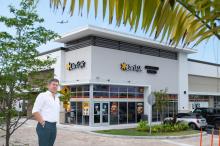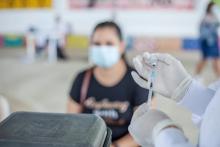
Based on the experience of other countries in the Central American region, the OECD will present a list of recommendations for the development of the sector in the Escuintla area.
Maya Camacho, policy analyst at the regional attraction unit of the Organization for Economic Cooperation and Development (OECD), was recently in Guatemala to start a regional investment attraction project.
This is the first mission called “first-hand contact”, to meet and interview representatives from different sectors and later, another mission of international experts will arrive. The idea is to provide recommendations and the execution of an action plan, in this type of projects.
Businessmen urge to digitize State services, which includes streamlining procedures
On April 25, construction of the Synergy Industrial Park complex began, with an investment of US$20 million, which will be located at kilometer 53 of the highway to the Pacific, promoted by the firms Spectrum and Grupo Pantaleón.
What is the objective of your visit to Guatemala?
In this regional attraction unit, we are developing a project called “rethinking the regional attractiveness for the inclusive and sustainable development of Escuintla.”
Our main objective is to support Guatemala in strengthening the attractiveness for inclusive and sustainable development, in line with the Government Plan and the 10 axes that President Bernardo Arévalo has mentioned to improve the conditions of citizens.
It should be clarified that Guatemala is not a member of the OECD as such, but it is part of an arm of the organization that is the Development Center, which includes countries from Africa, Asia and Latin America to facilitate dialogue on public policies with a focus on emerging and development economies.
What does it mean?
Being members of the Development Center since 2019, we had the interest in developing the project of rethinking the regional attractiveness and the interest in working with the Pantaleón Group, because we want to take advantage of the potential of the industrial park project that the organization is carrying out. , as a detonator for national development.
Since 2020 we have been working in 10 countries from different regions on the topic of regional attractiveness because there is a changing global environment due to multiple disruptions, whether from the Covid-19 crisis to the impact of the conflict between Russia and Ukraine. This can be seen somewhat far from Latin America, but in the end there is a high impact on global value chains and increases in energy rates that affect inflation rates on a global scale.
In something that we call in the OECD “the impact of megatrends”, such as climate change, digitalization, demographic change and all these global impacts, we see that they occur in an asymmetric way in countries and regions, but that they have affected different way and that is why we have begun to work on how to make regional attractiveness a tool for development.
What are the main background of what you are looking to do?
We have worked in 25 regions, many in Europe, but also in Latin America. In Colombia with the Pacific region, in Chile in Valparaíso and Magallanes and in Argentina in the province of Misiones, which is on the border with Brazil. Our main objective is to support Guatemala to analyze public policies of regional appeal.
What will be done in Escuintla, Guatemala?
As the OECD, a diagnosis will be carried out to provide recommendations on the exchange of good practices that help the inclusive and sustainable development of the region, which includes the industrial park and all its surroundings, because special economic zones are very important as a trigger and tool for development. regional.
It must be taken into account that there has often been criticism of industrial parks, because there may be negative externalities, but what we see here as a positive aspect is that there is good internal and external governance. An economic zone and industrial park can be a catalyst for national development.
In general, what is the topic that the diagnosis will address?
The Pantaleón group collaborates with the OECD with a report on the regional development of Escuintla, which is of great interest to us, as we have indicated in the report “Economic Perspectives for Latin America and the Caribbean.” To achieve sustainable development in Latin American countries, the recipe we have seen is that the levels and quality of investment must be increased to trigger that development.
So, what is needed are proactive investment strategies to accelerate economic and social progress and thus remedy the structural challenges that exist. In Latin American countries, including Guatemala, opportunities must be offered in the industrial, health, agribusiness and tourism sectors, adopting a new agenda to boost growth.
What axes will be analyzed?
Firstly, we analyze Escuintla's position internationally, that is, its attractiveness on a national and subnational scale for the region.
Then in the OECD there is a methodology called “regional attractiveness compass” and with the available data, an evaluation is made of all the strengths and weaknesses of the region and we make an evaluation with different indicators.
As an example, we have six domains: economic attractiveness, land and housing, social cohesion, connectivity and environment and we evaluate how the area is positioned, so we are going to create this compass of attractiveness to the Escuintla region.
Our interest is not to provide a good or bad score, but simply to see how it is positioned and creates an internationalization profile and from there, provide public policy recommendations.
As which?
In specific cases, how to improve the business and investment climate; public governance through efficient regulations with greater transparency; promote strategic sectors and growth opportunities that already exist, such as agriculture and renewable energies, as well as focus investment on telecommunications, water, transportation and clean energy infrastructure.
That is, favor and promote greater quality investment to implement a strategy of productive development and job creation.
When would the report be completed?
The project is for one year and a draft may be available by the end of 2024, so that it can be presented at the beginning of 2025.
What conclusions could be expected?
I would not like to advance any conclusions about the project, but something important is to do an institutional mapping and see how multilevel governance is achieved. How national, local and subnational public actors coordinate with those of the private initiative, how they interact and see what challenges and opportunities there are.
We not only analyze regional attractiveness with economic factors such as capital attraction, but also the whole at the level of social well-being.
What follow-up is expected for the recommendations?
One part of the project is the recommendations, but another is the implementation, so that it is not a report of recommendations that remains in a drawer, but rather creates an action plan and capabilities.









